Page 241 of 288

Driving with different tires reduces vehi
cle handling and can lead to a loss of
control.
- If the spare ti re is not the same as the
tires that are mounted on the vehicle -
for example with winter tires -only use
the spare tire for a short period of time and drive with extra care. Refit the nor
mal road wheel as soon as safely possi
ble.
- Never drive faster than the maximum
speed for which the tires on your vehicle
are rated because tires that are driven
faster than their rated speed can fail
suddenly.
- Overloading tires cause heat build-up,
sudden tire failure, including a blowout
and sudden deflation and loss of control.
- Temperature grades apply to tires that
are properly inflated and not over or un
derinflated.
- For technical reasons it is not always
possible to use wheels from other
vehicles -in some cases not even wheels
from the same vehicle model.
- If you install wheel trim discs on the ve
hicle wheels, make sure that the air flow
to the brakes is not blocked. Reduced air
flow to the brakes can them to overheat, increasing stopping distances and caus
ing a collision.
- Run flat tires may only be used on
vehicles that were equipped with them at the factory. The vehicle must have a
chassis designed for run flat tires. Incor
rect use of run flat tires can lead to vehi
cle damage or accidents. Check with an
authorized Audi dealer or tire specialist
to see if your vehicle can be equipped
with run flat tires. If run flat tires are used, they must be installed on all four
wheels. Mixing tire types is not permit
ted.
(D Note
- For technical reasons, it is not generally
possible to use the wheel rims from oth-
Tires and wheels 239
er vehicles. This can hold true for wheels
of the same vehicle type.
- If the spare tire is different from the
tires that you have mounted on your ve
hicle (for example winter tires or wide
profile tires), then use the spare tire for a
short period of time only and drive with
extra care. Replace the flat tire with the
tire matching the others on your vehicle as soon as possible.
- Never drive without the valve stem cap .
The valves could get damaged .
(® For the sake of the environment
Dispose of old tires in accordance with the
local requirements.
Uniform tire quality grading
-Tread wear
- Tract ion AA A B C
- Temperature AB C
Quality grades can be found where applicable
on the tire side wall between tread shoulder
and maximum section width
c;, page 236,
fig. 160.
For example: Tread wear 200, Traction AA,
Temperature A.
All passenger car tires must conform to Feder
al Safety Requirements in addition to these
grades.
Tread wear
The tread wear grade is a comparative rating
based on the wear rate of the tire when tested
under controlled conditions on a specified
government test course.
For example, a tire graded ISO would wear
one and one half (11/2) times as well on the
government course as a tire graded 100.
The relative performance of tires depends upon the actual conditions of their use, how
ever, and may depart significantly from the
norm due to variations in driving habits, serv
ice practices and differences in road character-
istics and climate.
ll-
•
•
•
Page 242 of 288

24 0 T ire s and wheel s
Traction
The traction grades, from highest to lowest,
are AA, A, Band
C. T hose grades represent the
tire's ability to stop on wet pavement as measured under controlled conditions on
specified government test surfaces of asphalt
and concrete. A tire marked C may have poor
traction performance
c:> .&. .
Te mp eratu re
The temperature grades are A (the highest),
B, and
C, representing the t ire's resistance to
the generation of heat and its ability to dissi
pate heat when tested under con trolled condi
tions on a specified i ndoor laboratory test
wheel.
Sustained high temperature can cause the
material of the tire to degenerate and reduce
tire life, and excessive temperature can lead
to sudden tire failure
c:> ,& .
The grade C corresponds to a level of perform
ance which all passenger car tires must meet under the Federal Motor Veh icle Safety Stand
ard No .
109 . Grades Band A represent h igher
l eve ls of pe rformance on the laboratory test
wheel than the m inimum required by law.
.&_ WARNING
T he traction grade assigned to this t ire is
based on stra ight-ahead braking traction
tests, and does not include acceleration,
cornering, hydrop laning o r peak traction
character istics.
A WARNING
The temperature grade for this tire is es
tablished for a t ire that is properly inflated
and not overloaded. Excessive speed, un
derinflation, or excessive loading, either
separately or in combination, can cause
heat buildup and possible tire fa ilu re.
-
Winter tires
Winter tires can improve vehicle handling on
snow and ice . At temperatures below 45 °F
(7 °C) we recommend changing to winter
tires.
In some heavy snow areas, local governments
may require true w inter o r "snow" t ires, those
with very deeply cut tread . T hese tires should
o n ly be used in pairs and be installed on a ll
f o ur wheels . Make sure you purchase snow
t ir es that are the same size and construction
type as the othe r tires on yo ur vehicle.
If your vehicle is equ ipped w ith all-whee l
drive*, t his w ill improve traction during win ter
driv ing, even with the standard tires . Howev
er, we strongly recommend that you always
equip all four wheels on your vehicle w ith cor
rect ly fitted winter tires or all-season t ires,
when winter road condit ions are expected.
This also improves the veh icle 's brak ing per
formance and reduces stopping d istances .
Summer tires provide less grip on ice and
snow.
Winter tires (snow tires) must always be fitted on all fo ur whee ls .
Ask your au thorized A udi dealer or qualified
workshop for permit ted
winter ti re size s. Use
only radial winter tires .
Winter tires lose their effec tivenes s whe n the
tread is wo rn down to a depth o f
0.157 inch
(4 mm) .
Only d rive w ith w inter t ires under w inte r co n
ditions. S umme r tir es handle bette r whe n
the re is no snow o r ice on the roads and the
temperature is above 45 °F (7 °C) .
If you have a flat ti re, see notes on spare
whee l
c:> page 236 .
Please always remember that winter tires may
have a lowe r speed rating than the tires o rigi
nally i nstalled on your vehi cle at the time it
was manuf actu red. P lease see
c:> page 237,
Speed rating (Letter code)
for a lis ting o f the
speed rating lette r codes and the max imum
speed at which the tires can be driven . ..,.
Page 243 of 288

The speed rating letter code (c::> page 228) is
on the side wall of the tire
c::> page 236.
A WARNING
Winter tires have maximum speed limits
that may be lower than your vehicle's max imum speed . Always know the maximum
speed before driving off . Never drive faster
than the speed permitted for your specific
w inte r tires . This will cause damage to the
t ires leading to an ac ciden t and se rious
pe rsonal in jury to you and yo ur passen
ge rs .
A WARNING
Dr iv ing faster than the maximum speed
for which the winter tires on your vehicle
were designed can ca use tire fai lure in
cl uding a blowout and sudden deflat ion,
loss of control, crashes and serious per
sonal injuries . Have worn or damaged tires
rep laced immed iate ly.
- Winter tires have maximum speed rat ing
that may be lower tha n your ve hicle's
maximum speed .
- Never drive faster than the speed for
w hich the winter or other tires installed
on your veh icle are rated .
A WARNING
Always adjust your d rivi ng to the road and
traffic conditions. Neve r let the good ac
c eleration of the w inte r ti res an d all-whee l
drive temp t you in to taking extra r is k s . A l
ways remember :
- When bra king, an a ll-wheel d rive vehicle
hand les in the s ame way as a front drive
vehicle.
- Drive carefu lly and reduce your speed on
icy and slippery roads, even winter tires
cannot he lp under black ice conditions.
@l For the sake of the environment
Use summe r tires w hen weathe r cond i
tions permit. They are quieter, do not we ar
as quickly and red uce fue l cons umption.
-
Tire s an d wheel s 241
Snow chains
Snow cha ins may be fitted only to the front
whee ls , a nd o nly to certa in ti re si zes. As k your
autho rized Aud i dea ler on whi ch tire sizes
snow chains can be used.
If you a re go ing to use snow cha ins, then you
mus t install t hem on the front whee ls a t
least.
T he snow chains must have low-p rofi le links
and must not be th ic ker than 0.53 inch
(13,S mm) , in cl ud ing t he lo ck.
Remove whee l cen ter covers and t rim discs
before putt ing snow cha ins on your veh icle
c::> (]) . For safety reasons cover caps must t hen
be fi tte d over the wheel bol ts. These are av ail
able from autho rized Aud i dealers .
A WARNING ,..__
Using the wrong snow chains for your vehi
cle o r insta lling them incorrect ly can in
crease the risk of loss of contro l leading to
serious personal injury.
- Snow chains are available in different
sizes . Always make sure to follow the in
structions prov ided by the snow chai n
manufacturer .
- When driving wit h snow cha ins neve r
drive faster than the speed permitted for
your specific snow chains .
- Always observe local regulations.
(D Note
- Remove snow c hains before driving o n
roads not covered with snow to avoid
damaging tires and wearing the snow
chains down unnecessarily.
- Snow chains, which come into direct con
tact with the whee l rim, ca n scratch or
damage it. Therefore, make sure that the
snow chains are suitably covered . Check
t he pos ition of the snow chains afte r
dr iv ing a few yards and co rrect if neces
sary. Follow the inst ru ct io ns from the
snow chain m anufacturer w hen do ing so. ..,.
•
•
•
Page 244 of 288

24 2 T ire s and wheel s
Where snow chains are mandatory oncer
tain roads, this normally also applies to
veh icles with all-wheel dr ive.
Wheel bolts
Wheel bolts must always be tightened to the
correct torque.
The design o f whee l bolts is matched to the
factory installed rims . If different rims are fit
ted, the correct wheel bolts with the right
length and correctly shaped bolt heads must
be used. This ensures that wheels are fitted
securely and that the brake system functions
correctly .
In certain circumstances, you may not use
wheel bolts from a different vehicle -even if it
is the same model
r=> page 270.
A WARNING
Improperly tightened or maintained wheel
bolts can become loose caus ing loss of
c ont ro l, a co llision and serious persona l in
Jury .
- Always keep the wheel bolts and the
threads in the wheel hubs clea n so the
wheel bolts can turn easily and be prop er ly t igh tened .
- Never grease or oil the wheel bo lts and
the threads in the wheel hubs. They can
become loose while d riving if greased or
oiled, even if tightened to the specified
torque.
- Only use wheel bolts that belong to the
rim being installed.
- Never use different whee ls bolts on your
vehicle.
- Always maintain the co rrect tighten ing
torq ue fo r th e wheel bo lts to reduce the
risk of a wheel loss . If the tightening tor
que of the wheel bo lts is too low, they
can loosen and come out w hen the veh i
cle is moving. If the tighteni ng torque is
too high, the whee l bolts and threads can be damaged and the whee
l can be
come loose.
@ Note
The specified torque for the whee l bolts is
90 ft lb (120 Nm) with a tolerance of± 7,4
ft lb(± 10 Nm) . Torque wheel bolts diago
nally. After changing a whee l, the torque
must be checked as soon as possible with a
torque w rench -preferably by an author
i zed Audi dealer or qualified workshop .
Low aspect ratio tires
Your Audi is factory-eq uipped w it h low aspect
ra tio tires. These tires have been tho roughly
tested and been se lected specifically fo r your
model for their superb perfo rmance, road fee l
and handling under a variety of d riving condi
t ions . Ask your author ized A udi dealer for
more details.
T he low aspect ratio of these tires is ind icated
by a numera l of
55 or less in the tire's s ize
designation. The n umera l represents the ratio
of the tire's sidewall height in relation to its
tread width expressed in percentage. Conven
t iona l tires have a he ight/w idth ratio of 60 or
more .
The performance of low-aspect -ratio tires is
particularly sens iti ve to imp roper inflation
pressure. It is therefore important that low
a spect ratio tires are inflat ed to the specified
pre ssure and that the inflation pressure i s
regularly ch ecked and maintain ed. Tire pre s·
sure s should be checked at lea st once a
m onth and always bef ore a long trip
r=> page 231, Checking tire pressure .
What you can do to avoid tire and rim
damage
Low aspect ratio tires can be d amage d more
easily by impact w ith potholes, curbs, gull ies
or ridges on t he road, particularly if the tire is
u nd eri nflated.
Page 245 of 288

In o rder to minimize the occu rrence o f impact
damage to the tires of your vehicle, we recom mend that you observe the following precau
tions :
- Always maintain recommended inflation
pressures. Check your tire pressure every
2,000 miles (3,000 km) and add a ir if neces
sary.
- Drive carefu lly on roads with potholes, deep
gullies or ridges. The impact from driving
t h rough or over such obstacles can damage
your tires. Impact with a curb may also
cause damage to your tires .
- After any impact, immediately inspect your
tires or have them inspected by the nearest
authorized Aud i dealer . Replace a damaged
t ire as soon as poss ible .
- In spect your t ires every 2,000 miles (3,000
km) for damage and wear . Damage is not al
ways easy to see. Damage can lead to loss of
air and unde rinflation, wh ic h could eventu
ally cause t ire fail ure.
If yo u be lieve that a
tire may have been damaged , replace the
tire as soon as possible.
- These tires may wear more qui ck ly than oth
ers.
- Please a lso remembe r that, whi le these t ires
deliver respons ive handling, they may ride
less comfortably and make more noise than
other choices.
Reduced p erformance in winter /cold
sea son condit ion s
All tires are designed for certain purposes .
The low aspect ratio, ultra hig h performance
tires originally installed on your vehicle are in
tended for max imum dry and wet road per
f ormance and handling . They are not suitable
for cold, snowy or icy weather cond it ions .
If
you dr ive under those circumstances, you
should equip your vehicle with all-season or
winter tires, which offer better traction under
those cond it io ns . We suggest you use the rec
ommended snow or all -season tires specified
for your ve hicle, or their equiva lent .
Refe r to ~
page 240 for mo re deta iled info r
ma tion regarding w in ter t ires.
Tire s an d wheel s 243
Tire pressure
monitoring system
ill General notes
Each tire, incl uding the spare (if provided),
shou ld be checked monthly when co ld and in
flated to the inflation pressure recommended by the veh icle manufac turer on the veh icle
placard or tire inflation pressure label. (If your
vehicle has tires of a different size than the
s ize indicated on the vehicle placard or tire i n
flat io n pressu re labe l, you shou ld dete rm ine
the p roper t ire inflation p ress ure fo r those
t i r es).
As an added safety feature , your veh icle has
been equipped with a tire pressure mon ito ring
system ( TPMS) that illum inates a low ti re
pressure te lltale when one or more o f your
t ires is significant ly under -inflated . Acco rding
l y, when the low tire pressure te lltale i llumi
nates, you should stop and check your tires as
soon as possib le, and inflate them to the
proper pressure. Driving on a sign ificantly un
der- inflated tire causes the tire to overheat
and can lead to tire fa ilure. Under-inflation al
so reduces fuel eff ic iency and tire tread life,
and may affe ct the vehicle's hand ling and
stopp ing ability.
Please note that the TPMS is not a substitute
fo r proper tire ma intenance, and it is the driv
er's respons ibility to maintain co rrect tire
pressure, even if under -inflation has not
rea ched the leve l to tr igger illuminat ion of the
TPMS low tire p ressure tellta le .
You r vehicle has also been equipped with a
T PMS ma lfunction indicator to ind icate when
the sys tem is not operating properly . T he
TPMS ma lfunction indicator is combined with
the low tire pressure te lltale. When the sys
tem detects a malfunction, the telltale will
flash for approximate ly one min ute and then
rema in continuously illum inated . Th is se
quence will continue upon subsequent vehicle
start-ups as long as the malfunct io n exists.
When the malfunction indicator is illum inat-
ed, the system may not be ab le to detect or
lilJ,
•
•
Page 246 of 288

24 4 T ire s and wheel s
signal low tire pressure as intended. TPMS
malfunctions may occur for a variety of rea
sons, includ ing the installat ion of replace
ment or a lternate tires or whee ls on the veh i
cle that prevent the TPMS from funct ioning
properly . Always check the TPMS malfunct ion
telltale after replacing one or more t ires or
wheels on your veh icle to ensure that the re
p lacement or a lternate tires and wheels allow
the TPMS to continue to function properly.
If the Tire Pressure Monitoring System
indicator appears
Applies to vehicles: with tire pressure monitoring system
The tire pressure indicator in the instrument
cluster informs you if the tire pressure is too
low or if there is a system malfunction.
F ig. 161 Ins trumen t cluste r: ind icato r light w it h m es
s age
Using the ABS sensors, the tire pressure moni
toring system compa res the tire tread circum
ference and vibration characteristics of the in
dividual tires .
If the pressure changes in one
or more tires, th is is indicated in the instru
ment cluster display with an indicator light
IE and a message ¢ fig. 161 . If only one t ire
is affected, the location of that t ire will be in
d icated. The message turns off after a few mi
nutes. You can disp lay the message again
¢ page 28.
The tire pressures must be stored in the menu
d isplay aga in each time the pressures change
(switching between part ia l and full load pres
sure) or after chang ing or replac ing a tire on
your ve hicle ¢
page 245. The tire pressure
monitoring system on ly monitors the ti re
press ure you have stored . You can find the rec
ommended tire pressures for your vehicle on the
labe l on the driver's doo r pillar
¢ page 229 .
Tire tread circumference and vib ration charac
teristics can change and cause a tire pressure
warning if:
- I f the tire pressure in one or more ti res is
t oo low.
- The tire has structural damage.
- The tire was replaced or the t ire pressure
changed and it was not stored again
¢ page 245.
-The spare tire is installed .
Indicator lights
IE -Loss of pressure in at least one tire ¢ .&. .
Check the tires and replace or repair if neces
sary. Check/correct the pressures of all four
t ires . Then store the t ire pressures in the
menu display
¢ page 245.
Ill (T ire Pressure Monitoring System) T ire
pre ssure: S ystem mal function!. Ifm:!
ap
pears afte r switching the ignition on or w hile
driv ing and the [ti] indicato r light in the in
strument cluster b links for app rox imately one
minute and then stays on , the re is system
malfu nction . Check/cor rect the p ress ures of
all four tires and store them¢
page 245. If
t h e indicator lig ht does turn off or tu rns on
again after a short pe riod of time, drive to
your authori zed Aud i dea ler or qualified repair
facility immed iately to have the malfunction
corrected .
A WARNING
--- If the tire pressure ind icator appears in
the instrument cluster display , one or
mo re of your t ires is sign ifi cant ly unde r
i n flated. Reduce yo ur speed immedi ately
an d avoid any hard steer ing or b rak ing
maneuvers. Stop as soon as possib le and
check the tires and their pressures. In
f late the tire pressure to the proper pres
sure as indicated on the vehicle's tire
pressure labe l
¢page 229. Driving on a
significantly under-i nflated tire causes
the t ire to overheat and can lead to ti re
fa ilur e. Unde r-inflation also is li kely to
Page 247 of 288

impair the vehicle's handling and stop
ping ability.
- The driver is responsible for maintaining
the correct tire pressures. You must
check the t ire pressures regularly.
- Under certain conditions (such as a spor
ty driving style, w inter condit ions or un
paved roads), the pressure monitor ind i
cator may be de layed.
- Ask your authorized dealer if run-flat
tires may be used on your vehicle. You ve
hicle registrat ion becomes invalid if you
use these tires when not permitted .
Damage to your vehicle or accidents
c ou ld also resu lt.
(0 Tips
- The t ire pressure monitoring system can
also stop work ing when there is an ESC/
ABS malfunction.
- Using snow chains may result in a system malfunction .
- The t ires with the ident ificat ion "AO" or
"RO"¢ page 236 have been matched
with you r A udi tire p ressu re monito ring
system. We recommend that you use
these tires.
- The t ire pressure monitoring system can
on ly mon itor the t ire pressure of the
driving tires . C he ck the tire pressure of
the spare wheel in the luggage compart
ment so that if necessary it is ready for
u se .
Storing tire pressures
Applies to vehicles: with tire pressure monitoring system
A change in tire pressure or a change in tires
must be stored in the system.
The ti re p ress ure is s to red in the M MI.
~ Make sure befo re stor ing that the tire pres
su res of all fou r tires meet the specified val
ues and a re adapted to the load. Otherw ise
the system co uld mal function ~
page 229.
~ Switch the ignition on.
~ Select : Sys tem s control button or Car sy s
tems > Servic e
& control > Tire pressure
Tire s an d wheel s 245
monitor > Store tire pre ssure > Ye s, store
now .
(D Tips
Do not s to re the tire pressures if snow
chains a re installed.
•
•
•
Page 248 of 288

246 What do I do now?
What do I do now?
Luggage compartment
lid emergency release
In case of an emergency , the rear lid can be
opened from the inside using the trunk es
cape handle .
Fig. 162 Re ar lid op ening : access to th e e merg en cy re
l ease
To reach the emergency release mechanism,
the rear bench seat backrest must be folded down
~ page 61 .
,. Push the latch upward in the direction of the
arrow until the lock releases .
The trunk escape handle inside the rear lid is
made of fluorescent material to glow in the
dark .
A WARNING
The trunk escape handle is to be used only
m an emergency .
@ Tips
The emergency release lever should never
be used as a handle for closing the rear lid.
General information
,. Park the vehicle as far as possible from mov
ing traffic in the event of a flat tire. In the
event of a flat tire, park the vehicle on a lev
el surface .
It you are on a steep incline, be
especially careful.
,. Set the parking brake.
,. Switch the emergency flashers on.
• Put on a reflective vest, if available.
• Setup the warning triang le, if available . •
Have the passengers exit the vehicle. They
should move to a safe place, for examp le
behind a guard rail.
A WARNING
-
Pay attention to the steps above. They are
for your protection and the for the safety of other drivers.
A WARNING
Improper use of the vehicle jack can cause
serious personal injuries .
- Never use the screw driver hex head to tighten wheel bolts, since the bolts cannot attain the necessary tightening tor
que if you use the hex head, potentially
causing an accident .
- The factory-supplied jack is intended on
ly for your vehicle model. Under no cir
cumstances should it be used to
lift
heavy vehicles or other loads; you risk in
juring yourself.
- Never start the engine when the vehicle
is raised, which could cause an accident.
- Support the vehicle securely with appro
priate stands if work is to be performed
underneath the vehicle; otherwise, there
is a potential risk for injury.
- Never use the jack supplied with your
Audi on another vehicle, particularly on a
heavier one. The jack is only suitable for
use on the veh icle it came with.
(D Tips
- Some of the onboard items listed above
are provided on certain models only or
are optional extras.
- Before storing the jack*, make sure it is
wound back down as far as it wil l go.
 1
1 2
2 3
3 4
4 5
5 6
6 7
7 8
8 9
9 10
10 11
11 12
12 13
13 14
14 15
15 16
16 17
17 18
18 19
19 20
20 21
21 22
22 23
23 24
24 25
25 26
26 27
27 28
28 29
29 30
30 31
31 32
32 33
33 34
34 35
35 36
36 37
37 38
38 39
39 40
40 41
41 42
42 43
43 44
44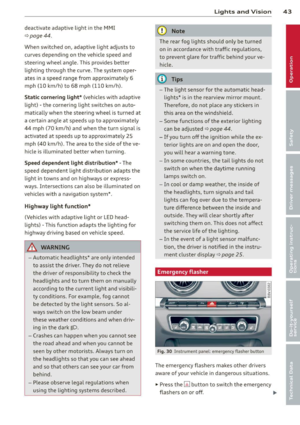 45
45 46
46 47
47 48
48 49
49 50
50 51
51 52
52 53
53 54
54 55
55 56
56 57
57 58
58 59
59 60
60 61
61 62
62 63
63 64
64 65
65 66
66 67
67 68
68 69
69 70
70 71
71 72
72 73
73 74
74 75
75 76
76 77
77 78
78 79
79 80
80 81
81 82
82 83
83 84
84 85
85 86
86 87
87 88
88 89
89 90
90 91
91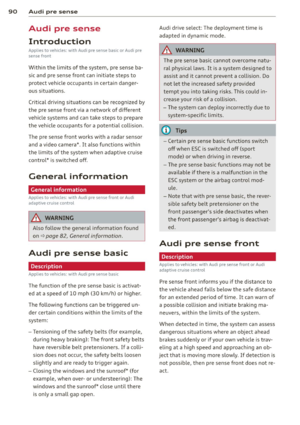 92
92 93
93 94
94 95
95 96
96 97
97 98
98 99
99 100
100 101
101 102
102 103
103 104
104 105
105 106
106 107
107 108
108 109
109 110
110 111
111 112
112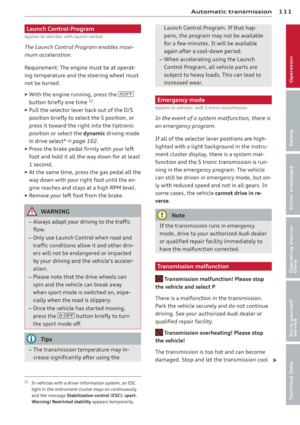 113
113 114
114 115
115 116
116 117
117 118
118 119
119 120
120 121
121 122
122 123
123 124
124 125
125 126
126 127
127 128
128 129
129 130
130 131
131 132
132 133
133 134
134 135
135 136
136 137
137 138
138 139
139 140
140 141
141 142
142 143
143 144
144 145
145 146
146 147
147 148
148 149
149 150
150 151
151 152
152 153
153 154
154 155
155 156
156 157
157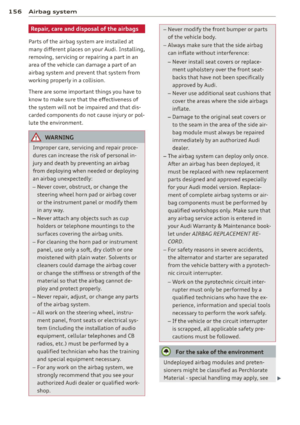 158
158 159
159 160
160 161
161 162
162 163
163 164
164 165
165 166
166 167
167 168
168 169
169 170
170 171
171 172
172 173
173 174
174 175
175 176
176 177
177 178
178 179
179 180
180 181
181 182
182 183
183 184
184 185
185 186
186 187
187 188
188 189
189 190
190 191
191 192
192 193
193 194
194 195
195 196
196 197
197 198
198 199
199 200
200 201
201 202
202 203
203 204
204 205
205 206
206 207
207 208
208 209
209 210
210 211
211 212
212 213
213 214
214 215
215 216
216 217
217 218
218 219
219 220
220 221
221 222
222 223
223 224
224 225
225 226
226 227
227 228
228 229
229 230
230 231
231 232
232 233
233 234
234 235
235 236
236 237
237 238
238 239
239 240
240 241
241 242
242 243
243 244
244 245
245 246
246 247
247 248
248 249
249 250
250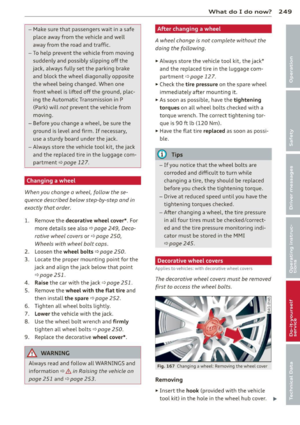 251
251 252
252 253
253 254
254 255
255 256
256 257
257 258
258 259
259 260
260 261
261 262
262 263
263 264
264 265
265 266
266 267
267 268
268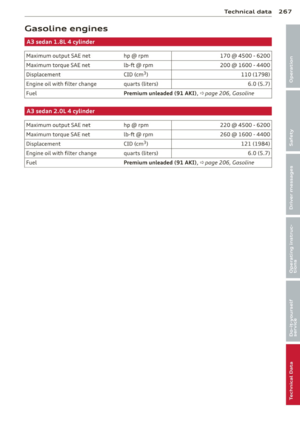 269
269 270
270 271
271 272
272 273
273 274
274 275
275 276
276 277
277 278
278 279
279 280
280 281
281 282
282 283
283 284
284 285
285 286
286 287
287






